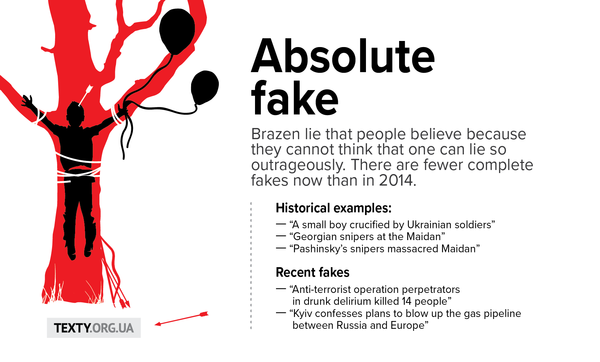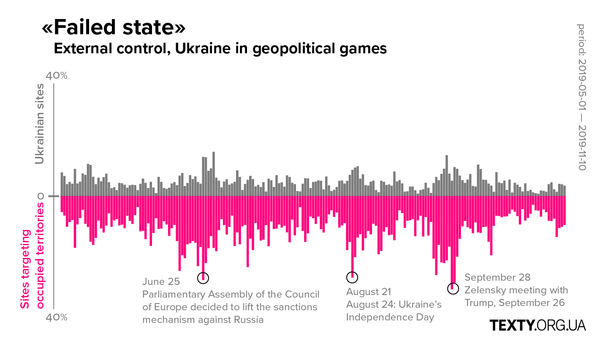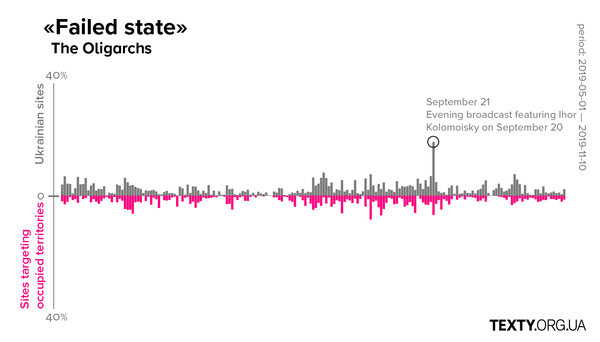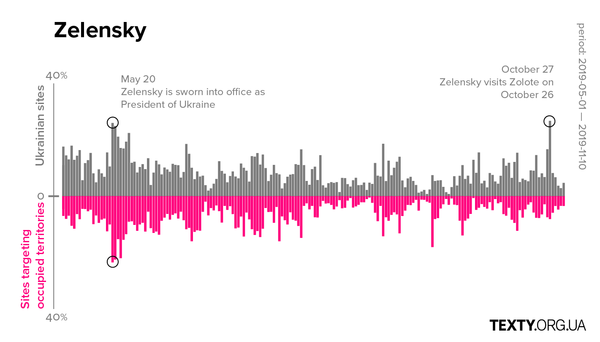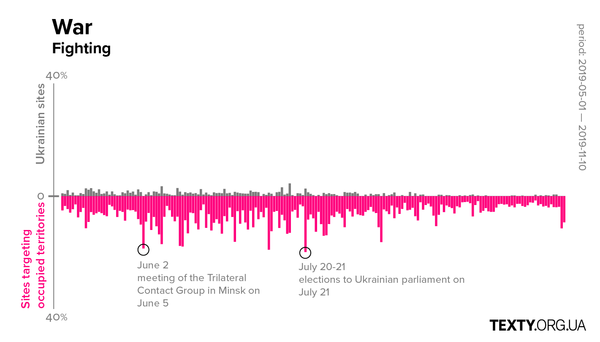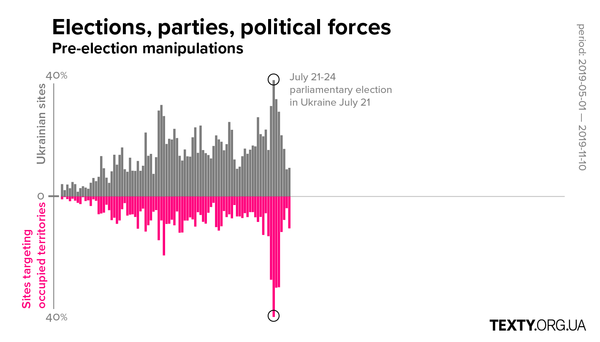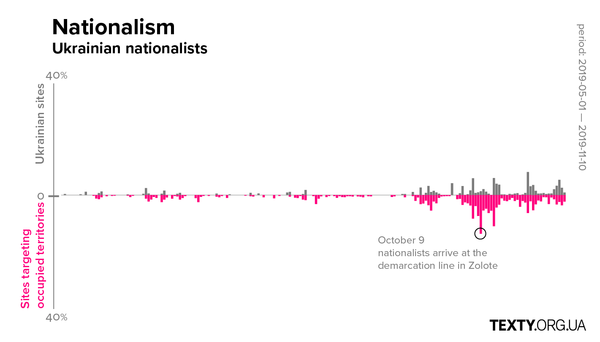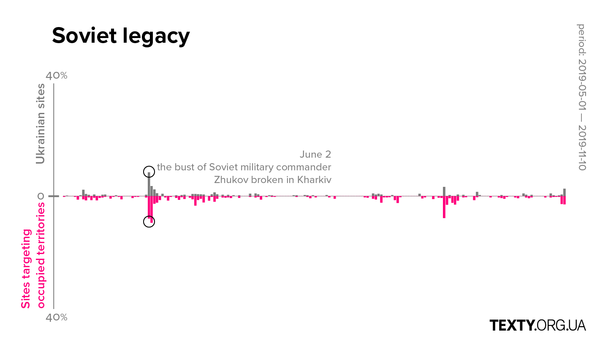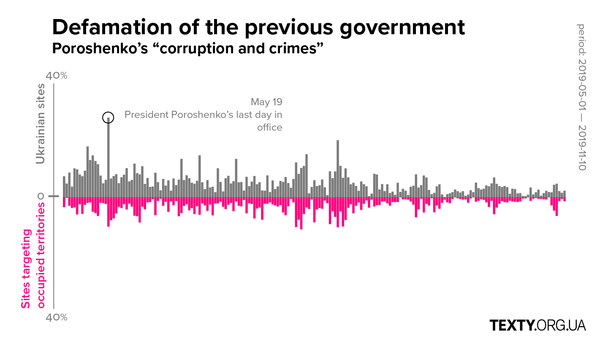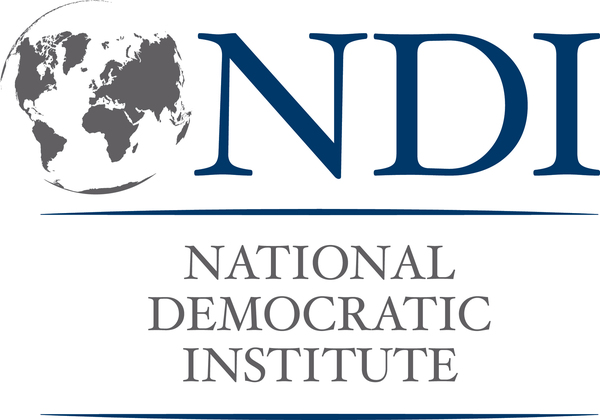Fortune tellers and clairvoyants, fake experts and useful idiots. The topics that Russian disinformation promotes and the methods it uses
Zelensky was initially mentioned neutrally in manipulative news, and sometimes hopes were voiced that he would get rid of the course of Ukraine’s previous leadership. However, with time, Zelensky's image in manipulative news becomes reminiscent of Poroshenko's image. Since May, we have been tracking the topics of Russian disinfo which appeared on Ukrainian junk news sites (also called toilet-tank sites) and in Russian disinformation publications targeted at Ukraine (published in the occupied territories of Donbass and in Russia). We are publishing main highlights of our study of Russian disinformation from May to November 2019 below.
Texty.org.ua editorial
Long-term tracking of disinformation makes it possible to see what topics are of most interest to the Russian authorities, who is the biggest irritant to them, and what they plan to do in the future.
You can find weekly reviews in English here, in Ukrainian here
Dashboard showing the dynamics of topics’ intensity is here
Strategic and short-term disinformation campaigns
Russian misinformation has different planning horizons. One can talk about long-term, mid-term, and short-term campaigns. In fact, the work of the Russian propaganda machine can be compared to a matryoshka: a large dollop conceals a smaller one, and an even smaller one is inside it.
The most long-term and systematic disinformation campaign is comprised of that entire array of manipulative news which can be logically combined under the umbrella name of “Failed state”. The purpose of this campaign is obvious. It aims to create an image of Ukraine as a non-state, an artificial state entity that arose against historical logic.
The attributes of this "Failed state" - in fact, its inherent constituents - are the themes of "impoverishment" and "nationalism". Since they have been actively promoted since the presidency of Viktor Yushchenko, they can also be classified as basic and long-term campaigns of Russian propaganda.
Mid-term campaigns include those aimed against the previous authorities or the current President Zelensky. There’s some differentiation: Poroshenko causes a complete rejection, yet it’s a bit different with Zelensky. On the one hand, he pursues the same "failed" policy of Poroshenko, risking to become just as "bloody", however, not a “chocolate man” but a “clown”. On the other hand, he himself is a potential victim of his predecessor. After all, Poroshenko is "preparing a coup".
These campaigns include short-term operations with more specific goals. One example is the emphasis on the need to imprison Poroshenko. Since the beginning of our monitoring in May 2019, we have seen disinformers regularly write that Poroshenko is being “locked up” or that he is “fleeing the country”. Subsequently, 12 cases having to do with Poroshenko did arise.
Disinformation timeline
Any information campaign, disinformation being no exception, is always tied to some specific events, news. Some events cause reaction after the event itself. Other events, on the contrary, are “helped to happen” before they even started.
Failed state
“Failed state” is one of the cornerstones of Russian disinformation. It appears more frequently in Russian disinformation publications than on Ukrainian junk news sites. The main "peak loads" of disinformation can be seen in the media of the occupied territories, and it is here that one can best trace what factors influence the activation of any specific topic of Russian propaganda.
Over the course of our observations, we have noticed several "peaks" of disinformation on the topic of “Failed state”. One of the peaks was on June 25, when the topic of external governance comprised over 30% of all the news in the occupied territories, while the number was twice less in the news on Ukrainian junk news sites.
The cause of such activity lies on the surface. It was on the night of June 24 to 25 that the Parliamentary Assembly of the Council of Europe decided to lift the sanctions mechanism against Russia. Accordingly, Russian propagandists were in a hurry to grab onto the “victory”. "News" from Russian sites are eloquent in themselves: "Russia returns to PACE. Ukraine does not seem to be very happy ” - Ukraine.ru was writing, for example.
The causes of other spikes in activity on the topic of ”Failed state” are not that obvious. They make one recall once again the claim that Russian disinformation is a long term game and its goals are global. For example, a peak of activity was on the 21st and partially on the 22nd of August, just a couple of days before Ukraine’s Independence Day. "Betrayal is a non-healing burn of the soul. How "Ukrainian multi-vector policy" finished in a dead end", reports e-news.su, a publication of the occupied territories.
On September 26, Zelensky meets with Trump, and against this background, another major splash of news on the topic of ”Failed state” happens. First of all, we are talking about the toilet tank sites in the occupied territories, which can be seen as an echo of the all-Russian wave of negativity and the desire to diminish the results of such a meeting. It can be assumed that Russian propaganda regarded the very fact of such a meeting as a threat to the assertions about Ukraine as a "non-state" or ”failed state” and so it decided to strike first.
The oligarchs
“The oligarchs” are a separate sub-theme to the topic of ”Failed state”. It is disseminated among both “mainstream” Ukrainian audiences and the residents of occupied territories. This topic had a peak of activity on September 21. On the evening before, a live broadcast on the TV channel "Ukraine" featured oligarch Ihor Kolomoisky on the phone. Some of the claims he voiced caused a whole information wave the next day.
All in all, Ihor Kolomoisky remains the most mentioned Ukrainian oligarch in the media. In disinformation publications, he is an excellent piece of material to illustrate the thesis of "Failed state" a non-state actually run by oligarchs. At the same time, Akhmetov, another Ukrainian oligarch, seems to be in the informational shadows, he is mentioned in a perfunctory manner, very often as the opponent of Kolomoisky.
Zelensky
Several peaks of activity peaks can be seen on this topic during June and July, but already in August, the number of news items is declining. Obviously, this is due to the fact that over time, the feeling of novelty of the new president is getting dull, and parliamentary elections also become a thing of the past.
In September and especially in October, the number of manipulative news about Zelensky on Ukrainian junk news websites begins to outweigh similar news on sites of occupied territories. On the one hand, there is a further activity on the Ukrainian sites, on the other, there’s a decrease in the number of manipulative and negative news about Zelensky in the publications of the occupied territories.
The strongest divergency in the media on different sides of the demarcation line could be observed on October 27. It was on this day that the maximum activity was recorded on the Ukrainian toilet tank sites when 25% of all manipulative news related to the topic of Zelensky while the media of occupied territories were surprisingly “restrained” with only about 6% of the news.
This discrepancy in numbers can be explained by the events that took place the day before in the unoccupied territory of Donbas. It was on October 26 that Volodymyr Zelensky arrived in the village of Zolote, where the separation of troops was planned. On October 27, the country continued to discuss the results of this visit.
However, Russian occupation authorities were in no hurry to inform the residents of occupied Donbas that the President of Ukraine had arrived on the front line.
Zelensky was initially mentioned neutrally in manipulative news, and sometimes hopes were voiced that he would get rid of the course of Ukraine’s previous leadership. However, with time, Zelensky's image in manipulative news becomes reminiscent of Poroshenko's image.
War
The number of manipulative news on the sites of occupied territories and on Ukrainian toilet tank sites on the topic of "War" differs significantly. It is natural that the media of the occupied territories pay more attention to the fighting. Quite often, the focus on this topic in the occupied territories does not correlate in any way with what Ukrainian media are writing at the same time.
June 2 is demonstrative in this respect when the media of the occupied territories were literally "feverish" with reports of another military escalation, while Ukrainian media were completely silent. Of course, one can assume that the purpose of such activity of the sites of the occupied territories is the need to remind residents of the occupied territories once again of the “atrocities” of the Armed Forces of Ukraine. However, by juxtaposing the schedule of “escalation” of hostilities in the media space of the occupied territories, and landmark political events that were taking place at the time, one can see another explanation for such "activity".
For example, a meeting of the Trilateral Contact Group on Donbas Resolution was scheduled for June 5, and Zelensky makes a number of statements on this matter on June 3.
Elections, parties, political forces
The peak of manipulative news on this topic was on July 21-23. On July 21, parliamentary elections were held in Ukraine. Notably, the activity of Russian disinformers here is almost equal on both sides of the frontline.
In the week after the snap parliamentary election, both Ukrainian crap sites and sites of the occupied territories were busy discussing the results.
In the flow of disinformation on the subject, there has been a lot of speculation about the potential of the new parliament. In particular, there were statements that the new parliament would be a little different from the previous one, that there would be “sold out votings” and influence of the oligarchs. The idea was pushed that all new persons in the parliament were in fact puppets controlled by the oligarchs. Partly, manipulation was focused on individual candidates, as well as those who lost the election. Publications of the occupied territories claimed a potential failure of the new parliament if peace was not reached on Russia's terms.
Pro-Russian opposition
In the "Pro-Russian Opposition" section, what draws attention is the focus of the Ukrainian toilet tank sites on a single political force, the OPFL of Viktor Medvedchuk. Based on who the Russian propagandists see as their information partners in Ukraine, it will definitely be OPFL and specifically the person of Viktor Medvedchuk. It is this political force that the lion's share of all disinformation messages is devoted to, and they are positive. The coverage of all other political forces that are considered "pro-Russian" is kept to a minimum.
Nationalism
The topic of "nationalism" is divided into several subtopics. While the "church" topic gets more attention at Ukrainian toilet tank sites, the topic of "Ukrainian nationalists" is more visible in the media of the occupied territories. The peak of activity on the subject of "Ukrainian nationalists" is on October 9. It was then that the media of the occupied territories were fanning information about nationalists arriving at the demarcation line in order to prevent troops from being separated in Zolote village.
Soviet legacy
The main triggers that activate news on this topic are decommunization, activities of the Ukrainian Institute of National Remembrance, its ex-head Volodymyr Viatrovych, celebrations of Soviet holidays. The largest peak of reports on junk news sites on both sides of the frontline on the subject of "Soviet legacy" was on June 2, when the bust of Soviet military commander Zhukov in Kharkiv was broken.
Economics and impoverishment
The number of news on the “Economics and impoverishment” topic has been steadily growing throughout the study. In June and July, the amount of such news is rather moderate, especially on Ukrainian junk news sites, but starting from August their number begins to grow steadily on both sides of the frontline. They use old scares about tariffs, pensions and, of course, the threat of default.
To this, a new information campaign is added which is aimed against the land market. It is actively promoted by OPFL and Medvedchuk personally who provide "correct" comments. First and foremost, of course, they talk about the sellout of Ukrainian blacksoil and the threat that the land will be bought up by some foreign structures.
Another permanent line of disinformation is about gas talks. There are some peaks of activity here, several of them, mostly on weekends, correlated with weekly summary issues on propaganda channels in both Russia and Ukraine.
Defamation of the previous government
During June-August, the main disinformation on this topic is focused on President Poroshenko. On the one hand, he is still accused of the "sins" of his time in power, on the other, he is shown as a threat of revanche for the new authorities.
Within the disinformation campaign dealing with Poroshenko, there is another clear line that can be separated out. It is the emphasis on the “need of” criminal prosecution of Poroshenko. Such disinformation, obviously, should create the visibility of public demand and motivate the authorities to take real action.
Since September, in addition to disinformation regarding Poroshenko, a considerable number of manipulative news has been reported regarding his entourage and ex-officials. Among the main victims of disinformation news are NBU ex-chief Valeria Gontareva, ex health minister Ulyana Suprun, ex-member of parliament Tatiana Chornovol and others.
Toolkit
The toolkit of Russian disinformation operations is rich. Professional disinformers have developed a wide range of tools and means.
Fake experts and useful idiots
For example, Russian propaganda uses various newsmakers (a politician or a person at the center of events; he or she says sensational things, and thus, “makes” news). There are many characters like this used by Russian propagandists. These include various "experts", "old" and "new" politicians, not even necessarily from the camp of pro-Russian forces. It is sometimes difficult to understand whether or not Ukrainian politicians are consciously making statements that are useful to Russian propaganda or whether are being used "in the dark."
However, the use of "experts" and newsmakers is not the limit.
Fortune tellers and clairvoyants
The Russian disinformation machine involves representatives of absolutely apolitical spheres. Russian propaganda materials occasionally use the testimony of all kinds of fortune-tellers and clairvoyants who prophesy the collapse of Ukraine or the approach of another apocalypse. For example, in a widely disseminated video, a famous Kazakh fortune-teller reads from a piece of paper, pausing as if she were seeing the text for the first time, her apocalyptic "predictions" about Ukraine.
Shifted accent
Disinformation news are not always pure fakes or voicing someone's thoughts. Very often, the news actually describes real events but shifting accents, having a spin, or "retouching" on certain facts. For example, the news "In Ivano-Frankivsk, MP from Poroshenko Bloc is flung feces at" describes a real attack on ex-MP Olexandr Shevchenko. However, the authors of the news "forgot" one detail, namely that - Mr. Shevchenko had already left the Poroshenko Bloc at the time of the attack. Ignoring this fact gives the news quite a different spin at the time of parliamentary campaign then going on in Ukraine.
Sources of dissemination
Material dissemination schemes also vary. Sometimes, this is reminiscent of genuine information special operations. TEXTY team explored one such case thoroughly. It was the dissemination of fake news about "greedy" and "drunk" Ukrainian soldiers. The primary source in this news was the “blog” of US Lieutenant Colonel Robert Tracy.
He shared his alleged negative impressions about Ukrainian soldiers. Interestingly, the blog itself actually existed. However, a closer look revealed that the blog was created shortly before the news was released, in August 2019. The special operation itself did not end there. This material has been featured not only on the "junk news sites" in Russia and Ukraine but also in seemingly reputable media. Those media later claimed that their websites were hacked and the “news” was featured there retroactively.
The tools and methods described above concern only a small part of the disinformation that is being poured on a daily basis by junk news sites upon the heads of Ukrainian citizens. The Russian propaganda machine continues to operate and, given recent events, its capacity will only continue to grow. Under these circumstances, it is crucial to understand what we are dealing with and how it works. Therefore, TEXTY will continue to explore this topic further.


